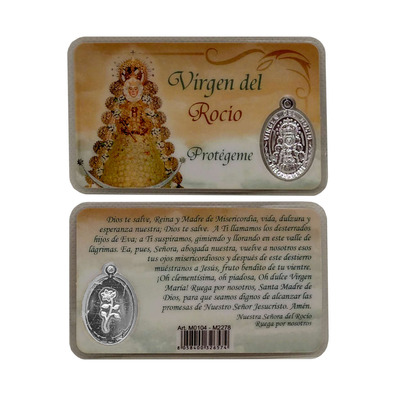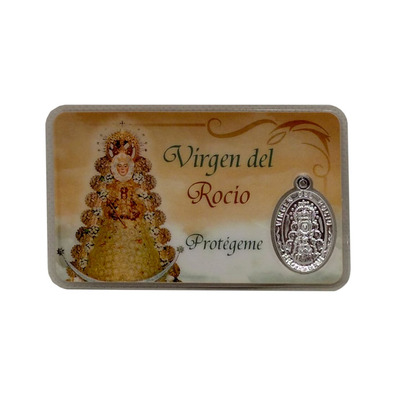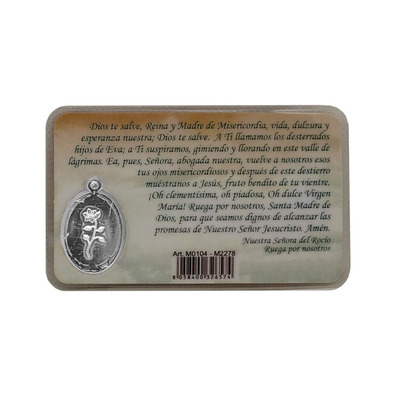Prayer Card of Our Lady of El Rocío with Medal
1,50€
Taxes includedCatholic product in stock. Products ready to be shipped. You can check the approximate delivery time during the purchase process.
Prayer Card of Our Lady of El Rocío with Medal
- Catholic prayer card.
- 8.5 cm (3.35 in) wide.
- 5.5 cm (2.17 in) high.
- Laminated in plastic.
- Includes a silver-plated brass medal with a relief image of St. Jude Thaddeus.
- Back of the prayer card includes a prayer.
History of the Marian Devotion to Our Lady of El Rocío
Our Lady of El Rocío, also known as the White Dove or the Queen of the Marshlands, is one of the most beloved Marian devotions in Spain, especially in Andalusia. Every year, thousands of pilgrims gather to honor her. The pilgrimage to El Rocío is one of the most important dates in the Andalusian calendar. It is a tradition that has been preserved for generations and holds a deep-rooted significance among the people.
Devotion to Our Lady of El Rocío dates back to the 13th century. According to tradition, a hunter from Almonte (a province in Huelva) discovered an image of the Virgin in the trunk of an oak tree within the marshlands of Doñana. Surprised by the discovery, the hunter carefully took the image to protect it from any damage. When he arrived at the village, he joyfully informed the locals about what he had found. However, when he was about to show the image, he realized it had disappeared.
The hunter and the villagers, astonished by this mysterious event, returned to the place where the image had first been seen. The image was peacefully resting in its original spot. This event was considered a miracle, leading to the construction of the first chapel.
This mystical discovery, which took place in an area originally known as La Rocina, marked the beginning of a devotion that now gathers more than a million pilgrims annually.
The devotion was supported by different monarchs and spread through the brotherhoods of El Rocío, which for centuries have organized pilgrimages and annual celebrations to honor the Virgin.
The Image of Our Lady of El Rocío
The original image of Our Lady of El Rocío is a wooden sculpture of French origin, according to most sources. It is estimated to have been created between the years 1280 and 1335. This original statue measured approximately 1 meter in height.
In the early years, the figure was called Our Lady of Remedies. After its discovery by the hunter, it was referred to as Saint Mary of the Rocinas, a name that lasted for many years until it became widely known as Our Lady of El Rocío.
Over the centuries, the image of Our Lady of El Rocío has undergone several modifications. In the 15th century, it underwent a major restoration that gave it a Gothic character.
By the late 16th century, the tradition of dressing the image in rich garments began. During this period, the figure underwent a significant transformation, with changes to its hands, the figure of the Child Jesus, and its gaze, giving it the characteristic downward glance that can be seen today.
It remained this way for nearly 100 years until the 17th century. At that time, the image underwent another modification to adapt it to the clothing styles of the period. This involved substantial alterations to the torso of the original statue.
Today, the figure of Our Lady of El Rocío has reached a height of 156 cm (61.42 in). Despite the modifications over the centuries, the sculpture retains original elements of its Gothic design, making it a unique symbol of history, art, and faith.
Medal of Our Lady of El Rocío in the Prayer Card
The prayer card of Our Lady of El Rocío includes a silver-plated brass medal featuring the silhouette of the Virgin.
The silhouette displays the characteristic elements of the figure of Our Lady of El Rocío.
Ornate Vestments: The Virgin wears a highly decorative mantle adorned with floral details and shimmering elements, evoking the Baroque style characteristic of her iconography.
Serene and Gentle Face: The image conveys an expression of peace and tenderness, with a loving and maternal gaze.
Royal Crown: She wears a large golden crown, symbolizing her celestial queenship.
Child Jesus in Her Arms: As in many Marian representations, she holds the Child Jesus, who is also dressed in decorative garments.
Surrounded by a Halo and Rostrum: Her image is framed by a golden halo, with decorative elements that emphasize her divinity. The face of the Virgin is adorned with a rostrum.
Crescent Moon at Her Feet: A crescent moon is depicted at her feet, a symbolic element of the Virgin as Queen of Heaven, referencing the vision from Revelation (12:1).








